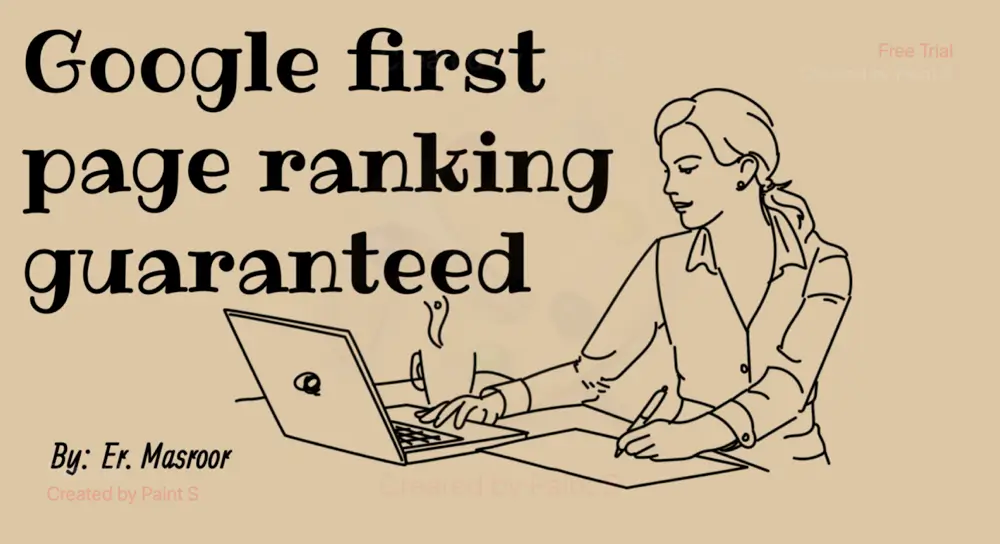Have you ever felt frustrated after trying many SEO tricks and services, taking courses, and wishing for top Google rankings but seeing no results?
Well, you’re in luck! Your solution is here. Follow these easy steps to get on the first page of Google for keywords that will boost your website’s traffic and sales in 2024:
1. Find your target Keyword
Keyword research means finding the right words people use to search online. These words help us get more visitors to our website.
You can use free or paid tools to do this. But let’s learn how to do it for free:
- Think of 15-20 words people might type when looking for your stuff. Include words for those who want to buy and those looking for information. Each word should be at least 3 words long.
For example, if I sell flowers online, I’d think of words like:
- Cheap flowers seller
- Best Flowers for love
- Artificial flowers for home decorating
And some words for people looking for information:
- How to buy online flowers
- Best flowers for wedding
- Best flowers range for Birthday party
Now experiment with these keywords like this:
- Take your initial list of keywords (around 15-20) and use a tool like “Keywordshitter” (yes, that’s the name) for about 2 minutes.
- Then, go to “searchvolume.io,” choose your target country, and enter the keywords you got from Keywordshitter. This will show you how often people search for those keywords.
- Download the list of keywords along with their search volume and open the file.
- Remove the keywords with really high search volumes (several thousand) and the ones with very low search volumes (10-100). Keep doing this until you have a list of 20-30 keywords left.
- Alternatively, you can use a tool like “Keywordtool.net” which can both generate keywords and provide search volume information.
- Lastly, install the “Moz bar” in your browser. Then, for each keyword, search it on Google and analyze the results using the Moz bar.
Results:
Check if at least two websites on the first page of Google have a Domain Authority (DA) lower than yours (which you figured out in the first step) and fewer than 5 links to their pages.
If you find such websites, you have a good chance of ranking for that keyword. Repeat this process for all 20-30 keywords you’ve gathered to identify which ones are worth targeting. Aim to have a final list of at least 5 keywords to focus on.
Understand Your Position in Google’s Perspective
It’s important to know: how strong your website is in the eyes of Google. It affects how you plan your SEO strategy.
Google’s opinion of your website’s strength decides which types of words will bring the most visitors to your site.
If your site is seen as very strong by Google, you can try to rank for tough words that usually bring in lots of visitors. But if your site isn’t that strong in SEO, you should aim for words that might not bring in as many visitors but are easier for a less strong website to rank for.
Usually, older websites have more strength because they’ve been around longer and have more links.
Here’s a simple 3-step way to find out how strong your website is:
- Go to Moz.com, sign up for a free account, and use their Link Explorer tool.
- Type in your website’s address.
- Write down your domain authority score.
If you want a detailed look at how well your website is doing in Google, you can also use a Google website rank checker tool. This helps you see how visible your website is in search results and keeps track of its ranking positions.
Create SEO optimized content
Now that you’ve determined which keywords to focus on and what type of content to make, it’s time to start creating it.
Chances are, you’ll be creating one of two types of content: a blog post or a page about your product or service. The good news is that the same SEO optimization principles apply to both of these content types.
1. Keyword-rich URL:
Your website’s URL should focus on the main keyword you want to rank for and should be reasonably short. For instance, if your target keyword is “Google first page guaranteed,” your URL should look like this: “greyknight17.com/google-first-page-guaranteed/“. Some people use the entire title in the URL, but that can make it too long. So, it’s best to avoid that.
2. Input the Main keywords in the title
Include your main keywords in the title of your page or post. Google sees synonyms similarly, so you can also use synonyms in the title. However, it’s not good for SEO to have a title that is completely unrelated to your content.
3. Add modifiers to the title
Modifiers such as “Best,” “Top,” “Cheapest,” or even the current year in the title can bring in extra traffic without much extra effort. People often include these modifiers when searching online. While it’s not always required to use them, it’s a simple and effective way to attract more visitors.
4. Wrap title in H1
While WordPress automatically puts the title in the H1 tag, some themes might change this by default. It’s important to check if your site’s theme does this and make the necessary corrections if needed.
5. Use multimedia like Images and videos
Using images and videos in your posts not only makes them look better but also increases the time a user spends on your site which is good for SEO.
6. Use H2 tag, External link & alt image
Use H2 tags for all your subheadings. Link to relevant external resources; it helps Google understand your page and improves the user experience. Don’t forget to add alt tags to your images; leave them blank.
7. Long content (Google loves it)
Recently, Google has been showing a preference for longer content instead of shorter pieces. Try to have at least 1500 words on a page. To take it a step further, consider creating content based on briefs from Content Harmony. These briefs provide specific topics to include in your content, helping you rank higher.
Make a backlink from a reputed Website
For any webpage to attract traffic, it must appear on the first page of Google’s search results. Unless your website is already very popular with significant authority, you’ll likely need backlinks (sometimes a large number of them) to reach that coveted first page.
The two types of links the page should have are:
1. Internal links
Internal links are links that come from other pages within your own website. These links are the easiest to obtain, yet many people tend to overlook their importance.
Here’s an example of an internal link: I’m internally linking to my post about Email Outreach lessons that I learned after sending 5,000 link-building emails.
Using internal links has two main advantages. First, they assist your pages in moving up the Google rankings. Second, they keep your website visitors engaged for longer periods, which is another factor Google considers when ranking sites.
2. External links
External links, which come from other websites, can be thought of as votes for your site. The more votes you gather, the higher your site is likely to rank on Google.
Backlinks, or these external links, remain one of the most influential factors in Google’s ranking system. However, they can be challenging to obtain on their own.
To acquire these links, you need to create a strategy for building links to your website and then put that strategy into action to earn those links.
If you’re just starting with link building, a good approach is, to begin with link exchanges and swaps with other website owners. When done in moderation, this tactic can yield positive results for improving your site’s visibility.
Track its Google ranking and traffic
The next step is to begin monitoring where your web pages appear in search results for their intended keywords. This way, you can receive real-time feedback on the effectiveness of your link-building efforts.
As you engage in activities such as building links, optimizing content, improving your website’s speed, or making other changes, your pages will either move up in search rankings or remain in the same position.
This information provides valuable insights into which activities are benefiting your SEO efforts the most. By using changes in ranking positions as feedback, you can focus more on activities that lead to higher rankings and reduce or eliminate activities that don’t yield positive results.
For tracking your rankings, you can use Serptoday’s free plan, which is particularly useful for bloggers who are just starting and have a limited budget.
Optimize the Page after it Gets on 1st Page
Once your webpage reaches the first page of search engine results, it’s essential to continue optimizing it to maintain or improve its ranking and attract more organic traffic. Here are some steps to optimize your webpage further:
- Monitor Performance: Regularly check the performance of your webpage in terms of traffic, bounce rate, and conversions. Use tools like Google Analytics to track visitor behavior.
- Keyword Refinement: Continue to research keywords related to your content and industry. Look for long-tail keywords and phrases that can help you target specific user intents. Incorporate these keywords naturally into your content.
- Quality Content Updates: Keep your content fresh and relevant. Update existing articles with new information, statistics, or insights. This signals to search engines that your content is up-to-date and valuable.
- User Experience (UX) Optimization:
- Ensure your webpage loads quickly. Use tools like Google PageSpeed Insights to identify and fix speed issues.
- Make sure your site is mobile-friendly, as mobile-friendliness is a significant ranking factor.
- Improve the overall design and layout for better user engagement.
Care also:
- High-Quality Backlinks: Continue to build high-quality backlinks from authoritative websites. Guest posting, content marketing, and outreach can help you acquire these backlinks. Avoid low-quality or spammy links.
- Social Signals: Engage with your audience on social media platforms. Shares, likes, and comments can indirectly influence your search engine rankings.
- Optimize Meta Data: Review and optimize your meta titles and meta descriptions. Ensure they accurately reflect the content of your pages and contain relevant keywords.
- Schema Markup: Implement schema markup to enhance your search engine listings with rich snippets, which can improve click-through rates.
- Local SEO (if applicable): If your webpage serves a local audience, optimize it for local SEO. This includes creating and maintaining a Google My Business listing and acquiring local citations.
- Internal Linking: Use internal links to connect related pages within your website. This helps users navigate your site and distributes link authority.
- User-Generated Content: Encourage user-generated content such as comments, reviews, and forums. User engagement can positively affect rankings.
- Structured Data: Implement structured data markup to provide search engines with more context about your content. This can lead to featured snippets or other rich search results.
- Monitor Competitors: Keep an eye on what your competitors are doing. Analyze their strategies and adjust your optimization efforts accordingly.
Remember that SEO is an ongoing process, and search engine algorithms evolve. Regularly staying updated with industry trends and search engine updates is crucial for maintaining and improving your website’s rankings on the first page.
More Read
About Us
SEOByMasroor.Com, is the place where we make learning easy. We’re here to help you with simple and clear instructions for all the things you want to learn. We believe that everyone can learn. SEOByMasroor is here to help you become better at things and make life a little simpler.





I offer mutually beneficial cooperation https://ztd.bardou.online/adm
Cool website. There is a suggestion https://ztd.bardou.online/adm
I really liked your site. Do you mind https://ztd.bardou.online/adm
Here’s what I can offer for the near future https://ztd.bardou.online/adm
Content for your website https://ztd.bardou.online/adm
Web Development Wizards https://ztd.bardou.online/adm
Can provide a link mass to your website https://ztd.bardou.online/adm
Your site’s position in the search results https://ztd.bardou.online/adm
SEO Optimizers Team http://myngirls.online/
I offer mutually beneficial cooperation http://myngirls.online/
Web Development Wizards http://fertus.shop/info/
Can provide a link mass to your website http://fertus.shop/info/
Your site’s position in the search results http://fertus.shop/info/
SEO Optimizers Team http://fertus.shop/info/
I offer mutually beneficial cooperation http://fertus.shop/info/
I really liked your site. Do you mind http://fertus.shop/info/
Here’s what I can offer for the near future http://fertus.shop/info/
You will definitely like it http://fertus.shop/info/
This piece of writing will help the internet users for creating new weblog or even a weblog from start to
end.
We absolutely love your blog and find the majority of
your post’s to be exactly I’m looking for. Does one offer guest writers to write content for
you? I wouldn’t mind writing a post or elaborating on a few
of the subjects you write regarding here. Again,
awesome web log!